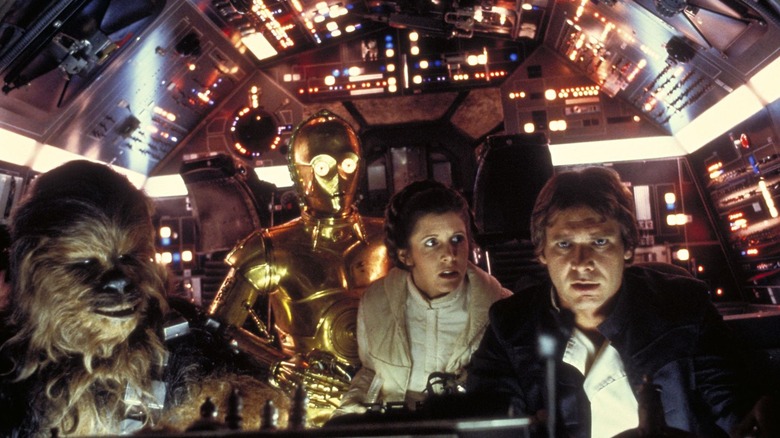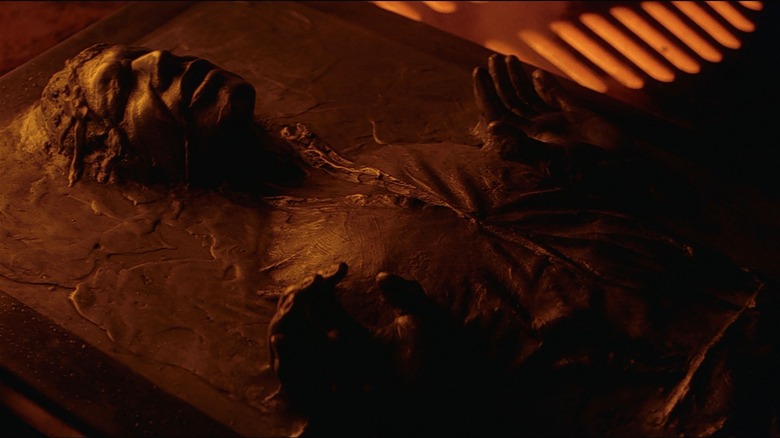Why Star Wars: The Empire Strikes Back's Carbon Freeze Scene Had People Fainting
"Oh, they've encased him in carbonite. He should be quite well protected, if he survived the freezing process, that is," quips C-3PO after Han Solo (Harrison Ford) is frozen alive in a slab of carbonite in "The Empire Strikes Back." It is a memorable scene, as it is preceded by Leia's (Carrie Fisher) declaration of love for Han, to which he replies with the characteristically suave, brilliantly ad-libbed "I know." The frozen Han is eventually handed over to Jabba the Hutt, whose lair is later infiltrated by Luke Skywalker (Mark Hamill) and gang to rescue their friend from his frozen state in "Return of the Jedi."
This is not the only instance of a person being carbon-frozen in the "Star Wars" universe. Although the process was widely used to encase and preserve transport materials (such as gaseous substances), it was often utilized to transfer sentient beings. Even Anakin Skywalker employed this idea to conceal himself from battle droid scanners in an episode of "Clone Wars," and Din Djarin used carbon-freezing to ensure the safe passage of his bounties after capturing them. The process was also used to freeze a giant kyber crystal during the Galactic Civil War, as seen in "Star Wars Rebels."
However, pulling off the carbon-freeze sequence in "The Empire Strikes Back" was hard, as no visual precedents existed for such an idea. In fact, according to Alan Arnold's "Once Upon a Galaxy: A Journal of the Making of The Empire Strikes Back," director Irvin Kershner made some last-minute changes to the scene to underline Lando Calrissian (Billy Dee Williams) and Darth Vader's motives for freezing Han, which were originally unclear in the finalized script. Lines were revised and further context was added to cushion the carbon-freezing scene, but some practical hangups occurred when the scene itself was shot.
Carbon freezing in Star Wars is serious business
Kershner spoke to Vanity Fair on the occasion of the film's 30th anniversary, and explained the "toughest shoot" was undoubtedly the carbon freeze scene, as a lot of steam was used to facilitate the staging of the scene, which caused some folks to faint:
"The toughest shoot was the Carbon Freeze scene. The set was painted black. It was a round set but we couldn't build the full circle because it would have been very hard to manipulate with the camera. So we built half of it, and it was a challenge because it was very hot and we were using lots of steam shooting out of the floor. Some of the little people fainted because they were closer to the steam. The staging was very difficult. The actors were about 30 feet off the ground and we had to be careful that they didn't fall."
Kershner has talked about the specifics of this scene on various occasions, explaining that he had to "shoot one direction and then change everybody around" and "shoot them for the reaction" due to the semi-circular nature of the set (via StarWars.com). A lot of back and forth was involved, as the crew also had to make sure that the carbon case itself looked just right for Harrison Ford to climb into, and Kershner recalled instructing Ford to fight his way out to convey a reaction more in line with Han's rebellious spirit.
"So I told him [Ford], 'Try to fight your way out of the slab.' And so he went back and they made a new one where he's pushing out with his hands, and that was the right one," Kershner explained, detailing the minute, essential aspects of a scene that feels unforgettable for a reason.

